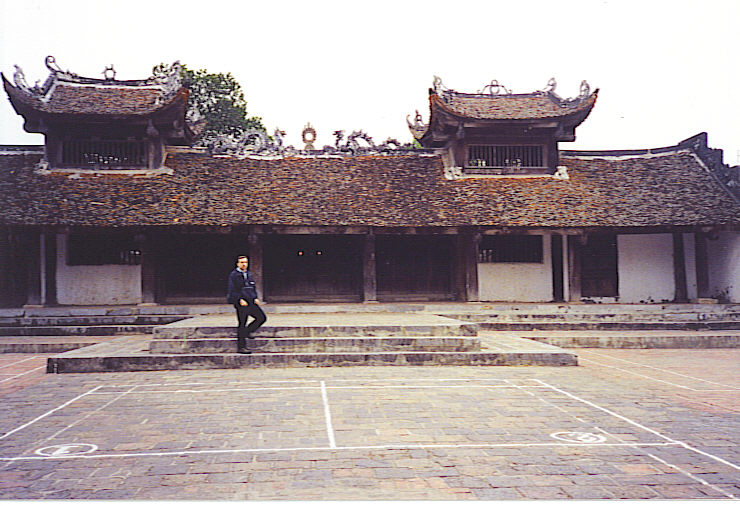 In my last post I reminisced about my first real traveling experience out of the USA – to Hanoi, Vietnam. Of all my memorable experiences there I enjoyed most meeting the Vietnamese people and eating the amazing food.
In my last post I reminisced about my first real traveling experience out of the USA – to Hanoi, Vietnam. Of all my memorable experiences there I enjoyed most meeting the Vietnamese people and eating the amazing food.
After traveling half way around the world I met up with a friend who had been in Hanoi for several months already. Not one of the rare western-style hotels for me; I lived in the local dorm of the National University, which was less impressive than it sounds. The small room in a stark building down a narrow street in a corner of town not usually seen by tourists meant that I spent most of my time in the midst of the locals and experienced Vietnamese life first hand. That included the local kids begging for money (one 4 year old put on her saddest looking face for my benefit) and the occasional swarm of 10 year olds competing to offer their shoe-shining prowess to me.
Many of my meals took place on the streets. And I mean this literally – squatting on the sidewalk eating Bun Nhan (duck noodle soup), Bun Oc (snail and noodle soup) or Bun Mum Tom (noodles dipped into a ghastly smelling shrimp paste). The proprietor would grab a handful of noodles, throw them briefly in boiling broth (with the chicken or duck bones still swimming around), and then ladle it into a bowl. You grabbed your own chopsticks from a cup holding a dozen or so (making sure you wiped them off before using, if you’re smart). Clean up is easy, you just throw everything on the ground. Generally an open sewer ran along the curb and everything went into it, including children relieving themselves as their proud parents looked on. As startling as this may seem to westerners, it was a normal occurrence. It also emphasized what was Vietnam’s greatest resource at the time – its people. There were so many people in Hanoi that each evening an army of men and women came out with large straw brooms and swept up the city. They even separated out usable materials from materials that have unquestionably reached the final state of being trash. Quite amazing.
Here’s a quick look at the street food in Hanoi posted on YouTube by uncorneredmarket. Note that this looks exceptionally upscale compared to most of the spots I ate.
Though my time in Vietnam was way too short I didn’t just stay in Hanoi. Hopping on the back of one of the Xe Om motorbike taxis I had rented for the day ($20 for two, a month’s income for the drivers), I ventured far out from the city to two of the small villages. Bach Trang specialized in making pottery, most of which was brought into Hanoi on bicycles or carts pulled by an ox or pony. The other village was called Nhing Heip, which was reached by an extremely bumpy Xe Om ride over rough roads. Nhing Heip is where they make fabric, and was the location of one of my fondest memories from the trip. Because very few westerners ever make it there, my oddly pale face attracted a great deal of attention. This was especially true with three little girls of about 4 years old who would run up to me and then run away and push their friends toward me, all the while laughing hysterically. My companion informed me that they kept saying “Look how white he is.” The commotion they were causing led to one of the girls’ grandfather seeing us and inviting us into his house for tea.

The house was actually a single room that resembled more a garage with a simple fabric covering the large opening. Over the course of the next 20 minutes or so we drank many cups of tea while he chatted away in Vietnamese about how America is rich and Vietnam is very poor but they work very hard (he was obviously proud of his culture). Of course, most of this I found out after the fact from my companion since I had learned only about 10 words of the language in my four days in Vietnam. I had no idea what he was saying but I enjoyed it immensely. It was a most delightful and memorable experience and one that I will treasure forever.
A conversation I didn’t understand of which I would be reminded years later when I engaged in another discussion where neither I nor the gentleman I was conversing with had any idea what we were saying to each other. More on that event in a later article.
More on my travels.
David J. Kent is an avid science traveler and the author of Lincoln: The Man Who Saved America, now available. His previous books include Tesla: The Wizard of Electricity and Edison: The Inventor of the Modern World (both Fall River Press). He has also written two e-books: Nikola Tesla: Renewable Energy Ahead of Its Time and Abraham Lincoln and Nikola Tesla: Connected by Fate.
Check out my Goodreads author page. While you’re at it, “Like” my Facebook author page for more updates!
Follow me by subscribing by email on the home page. Share with your friends using the buttons below.










